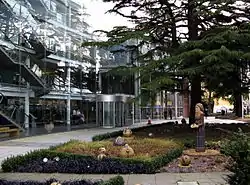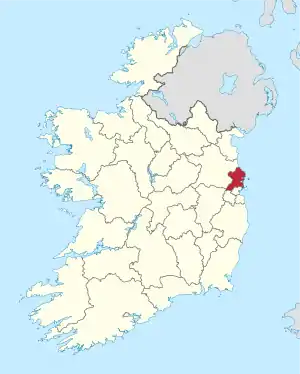Fingal County Council
Fingal County Council (Irish: Comhairle Contae Fhine Gall) is the authority responsible for local government in the county of Fingal, Ireland. It is one of three local authorities that comprised the former Dublin County Council before its abolition on 1 January 1994 and is one of four councils in the Dublin Region. As a county council, it is governed by the Local Government Act 2001. The council is responsible for housing and community, roads and transport, urban planning and development, amenity and culture, and environment. The council has 40 elected members. Elections are held every five years and are by single transferable vote. The head of the council has the title of Mayor. The county administration is headed by a Chief Executive, AnnMarie Farrelly. The county town is Swords.
Fingal County Council Comhairle Contae Fhine Gall | |
|---|---|
 | |
 | |
| Type | |
| Type | |
| Leadership | |
David Healy, GP | |
| Structure | |
| Seats | 40 |
 | |
Political groups |
|
| Elections | |
Last election | 24 May 2019 |
| Motto | |
| Flúirse Talaimh is Mara (Irish) "Abundance of Land and Sea" | |
| Meeting place | |
 | |
| County Hall, Swords | |
| Website | |
| fingalcoco | |

History
Dún Laoghaire–Rathdown County Council came into being on 1 January 1994.[1][2]
The county council initially met at the former offices of the abolished Dublin County Council, an office block at 46-49 O'Connell Street, Dublin.[3] A new building, known as County Hall, was purpose-built for the county council and completed in 2000.[4]
Administrative area
The county of Fingal covers an area of 456 km2 and has 88km of coastline stretching from Sutton in the south to Balbriggan in the north.[5] It is drained by the River Delvin along its northern boundary, the Ward and Broadmeadow rivers in the centre, the Tolka and Santry rivers to the south. The River Liffey forms its southern border with South Dublin. There are three large protected estuaries and salt marsh habitats, with thirteen major beaches. Howth Head and the Liffey Valley are covered by Special Area Amenity Orders.
Local Electoral Areas
Fingal County Council has 40 seats, divided into the following seven local electoral areas, defined by electoral divisions.[6]
| LEA | Definition | Seats |
|---|---|---|
| Balbriggan | Balbriggan Rural, Balbriggan Urban, Holmpatrick and Skerries | 5 |
| Blanchardstown–Mulhuddart | Blanchardstown-Abbotstown, Blanchardstown-Corduff, Blanchardstown-Mulhuddart, Blanchardstown-Tyrrelstown, Dubber, The Ward;and those parts of the electoral divisions of Blanchardstown-Blakestown and Blanchardstown-Coolmine north of a line drawn along the N3 dual carriageway | 5 |
| Castleknock | Blanchardstown-Delwood, Blanchardstown-Roselawn, Castleknock-Knockmaroon, Castleknock-Park, Lucan North; the part of Blanchardstown-Blakestown electoral division situated within the following line: Commencing at the intersection of the boundary between the electoral divisions of Blanchardstown-Blakestown and Lucan North with the R121 Road at the Clonsilla railway station bridge; (referred to hereafter as the first-mentioned point); then proceeding in a north easterly direction along the R121 road to its intersection with the Clonsilla link road; then proceeding in a northerly direction along the Clonsilla link road to its intersection with the Ongar distributor road; then proceeding in a south-easterly direction along the Ongar distributor road to its intersection with Shelerin Road; then proceeding in a southerly direction along Shelerin Road to its intersection with Clonsilla Road; then proceeding in an easterly direction along Clonsilla Road to its intersection with Porterstown Road; then proceeding in a southerly direction along Porterstown Road to the railway line; then proceeding in a westerly direction along the railway line to the first-mentioned point;and that part of the electoral division of Blanchardstown-Coolmine not contained in the local electoral area of Blanchardstown-Mulhuddart | 6 |
| Howth–Malahide | Baldoyle, Howth, Malahide East, Malahide West, Portmarnock North, Portmarnock South, Sutton;and those parts of the electoral divisions of Balgriffin, Kinsaley and Swords-Seatown not contained in the local electoral area of Swords | 7 |
| Ongar | That part of the electoral division of Blanchardstown-Blakestown not contained in the local electoral area of Castleknock and not contained in the local electoral area of Blanchardstown-Mulhuddart | 5 |
| Rush–Lusk | Ballyboghil, Balscadden, Clonmethan, Donabate, Garristown, Hollywood, Lusk and Rush | 5 |
| Swords | Airport, Kilsallaghan, Swords-Forrest, Swords-Glasmore, Swords-Lissenhall, Swords Village, Turnapin; and those parts of the electoral divisions of Balgriffin, Kinsaley and Swords-Seatown west of a line drawn along the M1 motorway. | 7 |
Councillors
2019 seats summary
| Party | Seats | |
|---|---|---|
| Fianna Fáil | 8 | |
| Fine Gael | 7 | |
| Labour | 6 | |
| Green | 5 | |
| Sinn Féin | 4 | |
| Social Democrats | 2 | |
| Inds. 4 Change | 1 | |
| Solidarity–PBP | 1 | |
| Independent | 6 | |
Councillors by electoral area
This list reflects the order in which councillors were elected on 24 May 2019.[7]
- Notes
- Replaced during term, see table below for details.
Co-options
| Party | Outgoing | Electoral area | Reason | Date | Co-optee | |
|---|---|---|---|---|---|---|
| Green | Joe O'Brien | Balbriggan | Elected as a TD for Dublin Fingal at the 2019 by-election. | November 2019 | Karen Power | |
| Green | Roderic O'Gorman | Castleknock | Elected as a TD for Dublin West at the 2020 general election. | February 2020 | Pamela Conroy | |
| Social Democrats | Cian O'Callaghan | Howth–Malahide | Elected as a TD for Dublin Bay North at the 2020 general election. | February 2020 | Joan Hopkin | |
| Sinn Féin | Paul Donnelly | Ongar | Elected as a TD for Dublin West at the 2020 general election. | February 2020 | Aaron O'Rourke | |
| Labour | Duncan Smith | Swords | Elected as a TD for Dublin Fingal at the 2020 general election. | February 2020 | James Humphreys | |
| Fine Gael | Emer Currie | Castleknock | Nominated by the Taoiseach to Seanad Éireann. | June 2020 | Siobhan Shovlin | |
Governance
The Mayor and Deputy Mayor are chosen from among the Councillors.[8] The Chief Executive – Anne Marie Farrelly – is appointed by central government[9]
References
- "Local Government (Dublin) Act 1993, § 9: Establishment and boundaries of administrative counties". Irish Statute Book. 21 December 1993. Retrieved 15 September 2020.
- "Local Government (Dublin) Act 1993 Commencement Order 1993". Irish Statute Book. 22 December 1993. Retrieved 12 September 2020.
- "Fingal council to build new county offices in Swords". Irish Times. 4 September 1996. Retrieved 1 November 2019.
- "Fingal's offices are greenest of all". Irish Times. 9 November 2000. Retrieved 1 November 2019.
- "Fingal Climate Change Adaptation Plan" (PDF). Fingal County Council.
- "County of Fingal Local Electoral Areas Order 2018". 19 December 2018. Retrieved 16 February 2019.
- "Local Elections 2019: Results, Transfer of Votes and Statistics" (PDF). Department of Housing, Planning and Local Government. pp. 104–111. Retrieved 15 September 2020.
- Per Schedule 8 of the Local Government Act, 2001, the Council resolved to give to the office of its chairperson and vice-chairperson the title of "Mayor" or "Deputy Mayor", respectively.
- http://www.fingal.ie/your-council/management-team/